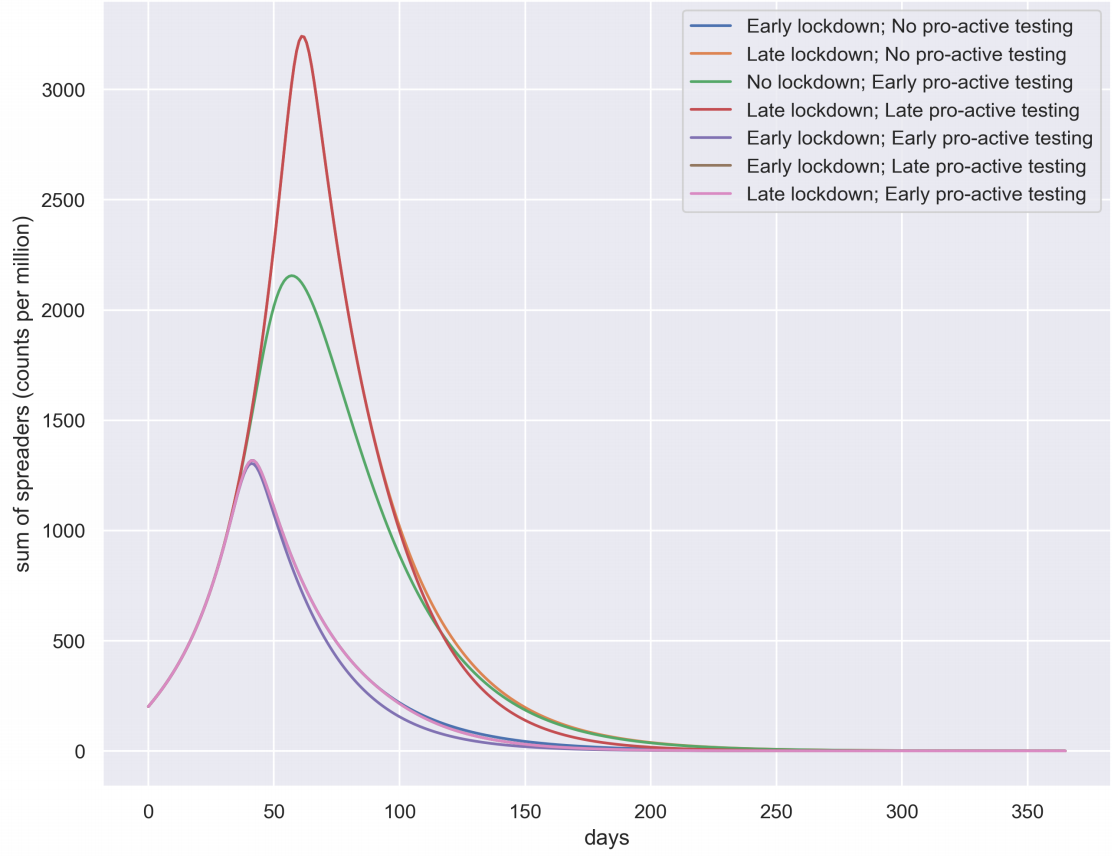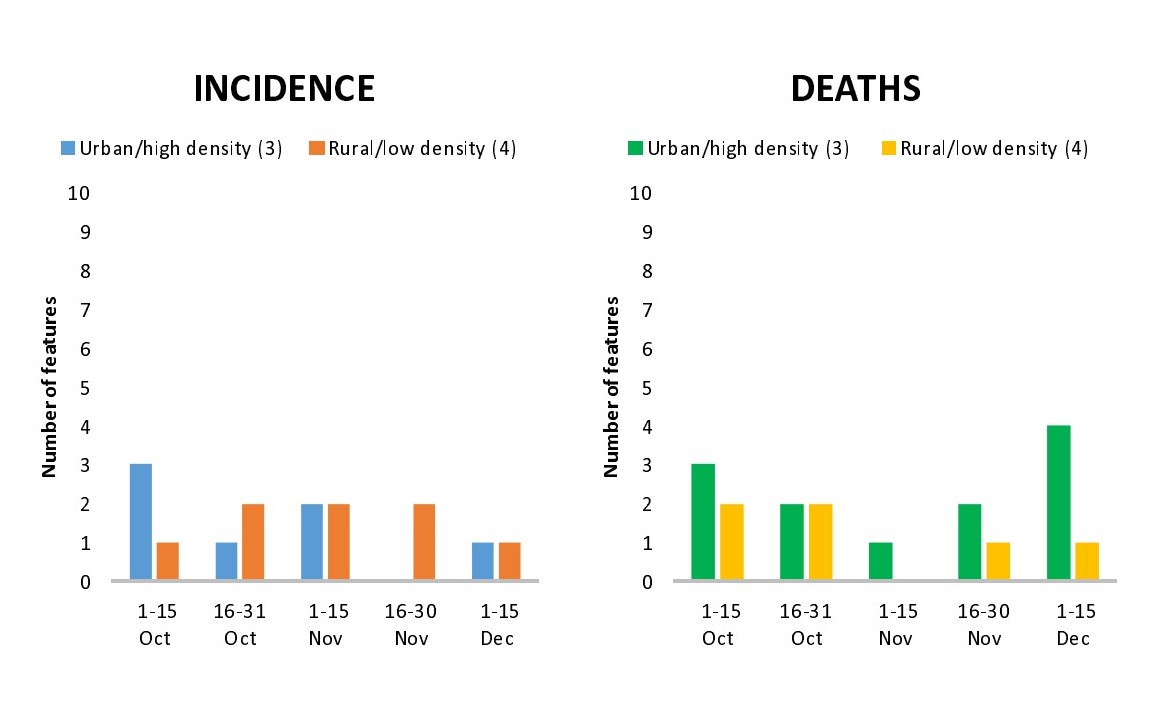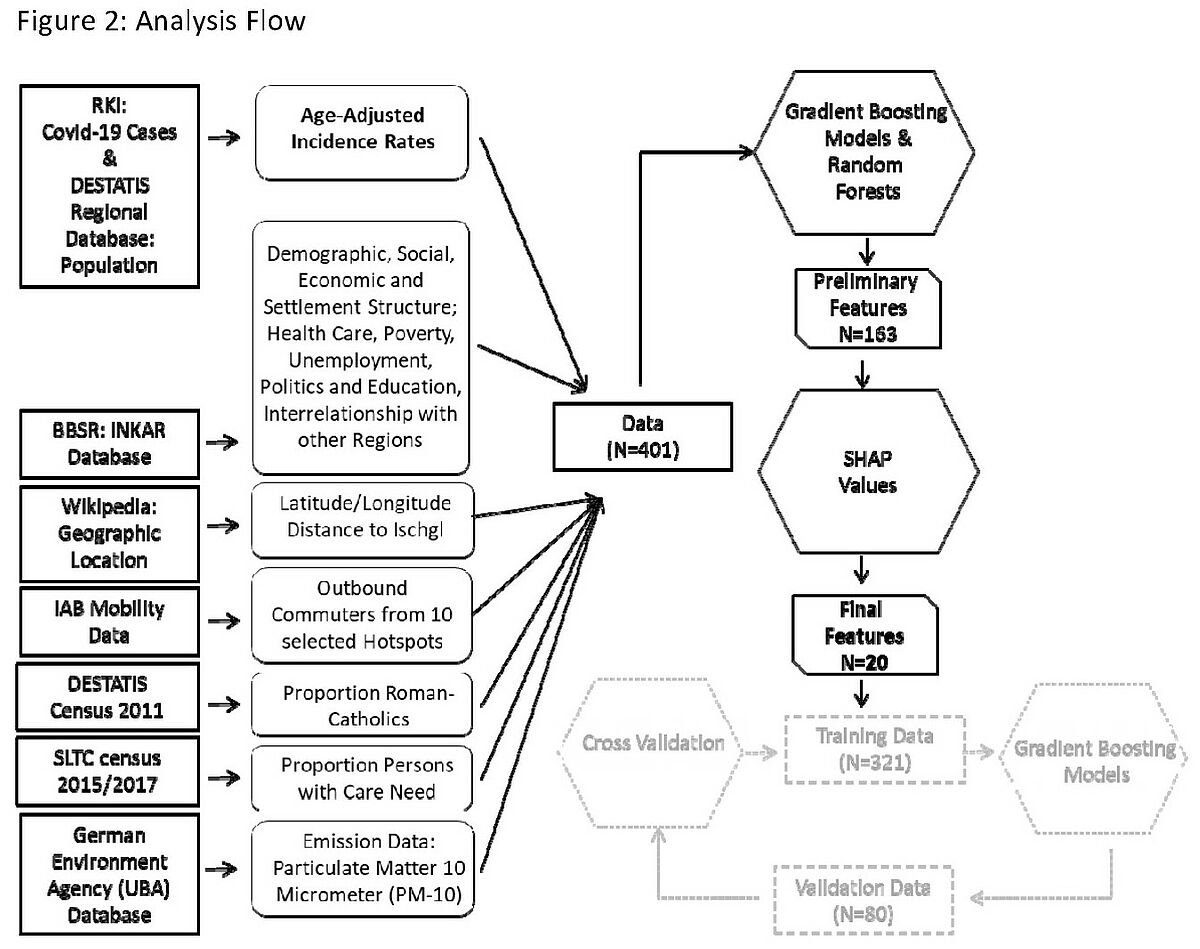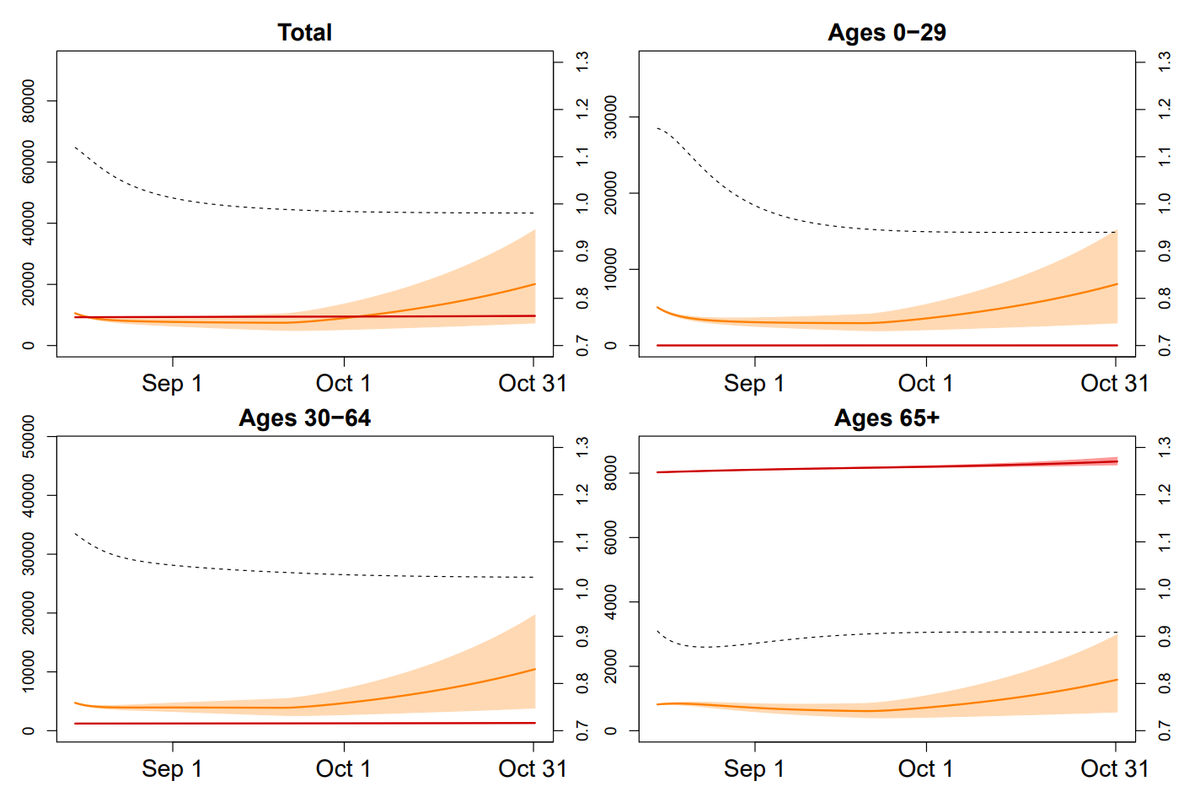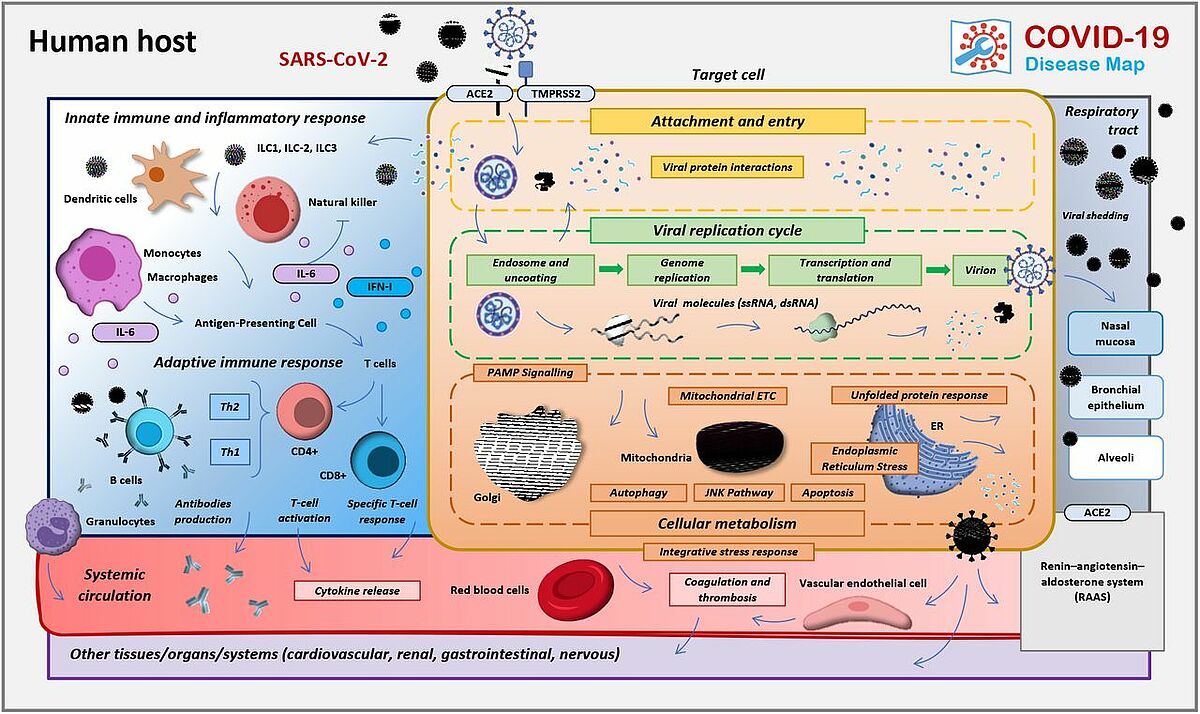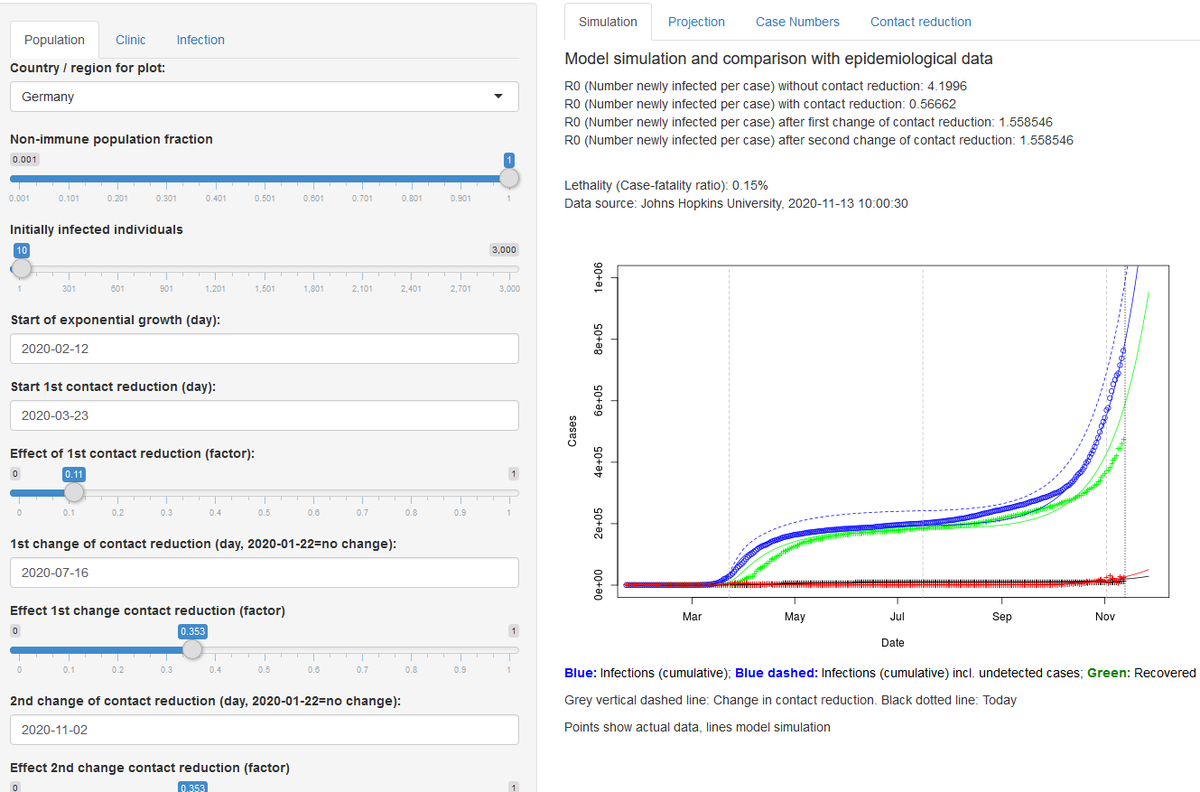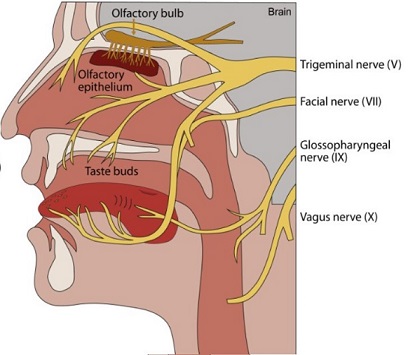Analyzing the timing of contact restrictions and the role of pro-active testing
Saptarshi Bej, Olaf Wolkenhauer
During the SARS-CoV-2 pandemic, numerous mathematical models have been developed. Reporting artefacts and missing data about asymptomatic spreaders, imply considerable margins of uncertainty for model-based predictions. Epidemiological models can however also be used to investigate the consequences of measures to control the pandemic, reflected in changes to parameter values. We developed a SIR-based, SUIR model in which the influence of testing and a reduction of contacts is studied by distinguishing 'Unidentified' and 'Identified' spreaders of infections.
The model uses four ordinary differential equations and is kept deliberately simple to investigate general patterns occurring from testing and contact restrictions. The model goes beyond other efforts, by introducing time dependent parameter curves that represent different strategies in controlling the pandemic. Our analysis reveals the effect of 'pro-active' testing for the design of contact restriction measures. By pro-active testing we mean testing beyond those people who show symptoms. The simulations can explain why the timing of contract restrictions and pro-active testing is important. The model can also be used to study the consequence of different strategies to exit from lockdown. Our SUIR model is implemented in Python and is made available through a Juypter Notebooks. This an extensive documentation of the derivation and implementation of the model, as well as transparent and reproducible simulation studies. Our model should contribute to a better understanding of the role of testing and contact restrictions.
- Bej S, Wolkenhauer O (2020): The timing of contact restrictions and pro-active testing balances the socio-economic impact of a lockdown with the control of infections. medRxiv doi.org/10.1101/2020.05.08.20095596
The second wave of SARS-CoV-2 infections and COVID-19 deaths in Germany – driven by values, social status and migration background? A county-scale explainable machine learning approach
Gabriele Doblhammer, Daniel Kreft, Constantin Reinke
We used 155 indicators to characterize counties in nine geographic, social, demographic, and health domains. For each period, we calculated directly age-standardized COVID-19 incidence and death rates on the county level. We trained gradient boosting models to predict the incidence and death rates with the 155 characteristics of the counties for each period. To explore the importance and the direction of the correlation of the regional indicators we used the SHAP procedure. We categorized the top 20 associations identified by the Shapley values into twelve categories depicting the correlation between the feature and the outcome.
We considered information on COVID-19 diagnoses and deaths from 1. October to 15. December 2020 on the county-level, differentiating five two-week time periods.
We found that counties with low SES were important drivers in the second wave, as were those with high international migration and a high proportion of foreigners and a large nursing home population. During the period of intense exponential increase in infections, the proportion of the population that voted for the Alternative for Germany (AfD) party in the last federal election was among the top characteristics correlated with high incidence and death rates.
We concluded that risky working conditions with reduced opportunities for social distancing and a high chronic disease burden put populations in low-SES counties at higher risk of SARS-CoV-2 infections and COVID-19 deaths. In addition, noncompliance with Corona measures and spill-over effects from neighbouring counties increased the spread of the virus. To further substantiate this finding, we urgently need more data at the individual level.
- Doblhammer, Kreft, Reinke (2021): The second wave of SARS-CoV-2 infections and COVID-19 deaths in Germany - driven by values, social status and migration background? A county-scale explainable machine learning approach. doi: https://doi.org/10.1101/2021.04.14.21255474.
Social disparities in the first wave of COVID-19 infections in Germany: A county-scale explainable machine learning approach
Gabriele Doblhammer, Daniel Kreft, Constantin Reinke
Little is known about factors correlated with the socioeconomic spread of the first wave of COVID-19 infections in Germany. We explored whether the risk of COVID-19 infections differed between regions according to their socioeconomic characteristics. We trained gradient boosting models to predict the age-standardized incidence rates with the macro structures of the counties, and used SHAP values to characterize the 20 most prominent features in terms of negative/positive correlations with the outcome variable.
We used data from the Robert-Koch-Institute on COVID-19 diagnoses differentiating five distinct periods between 1 April and 23 July 2020. For each period we calculated age-standardized incidence of COVID-19 diagnoses on the county. We characterized the regions by macro variables in nine domains: “Demography”, “Employment”, “Politics, religion, and education”, “Income”, “Settlement structure and environment”, “Health care”, “(structural) Poverty”, “Interrelationship with other regions”, and “Geography”. We trained gradient boosting models to predict the age-standardized incidence rates with the macro structures of the counties, and used SHAP values to characterize the 20 most prominent features in terms of negative/positive correlations with the outcome variable.
Results: The first COVID-19 wave started as a disease in wealthy rural counties in southern Germany, and ventured into poorer urban and agricultural counties during the course of the first wave. The negative social gradient became more pronounced from the 2nd lockdown period onwards, when wealthy counties appeared to be better protected. Features related to economic and educational characteristics of the young population in a county played an important role at the beginning of the pandemic up to the 2nd lockdown phase, as did features related to the population living in nursing homes; those related to international migration and a large proportion of foreigners living in a county became important in the post-lockdown period.
Conclusion: High mobility of high SES groups may drive the pandemic at the beginning of waves, while mitigation measures and beliefs about the seriousness of the pandemic as well as the compliance with mitigation measures put lower SES groups at higher risks later on.
- Doblhammer G, Kreft D, Reinke C (2020): Social disparities in the first wave of COVID-19 infections in Germany: A county-scale explainable machine learning approach. medRxiv doi: https://doi.org/10.1101/2020.12.22.20248386
The Effect of Gender on Covid_19 Infections and Mortality in Germany. Insights From Age- and Sex-Specific Modelling of Contact Rates, Infections, and Deaths
Achim Dörre, Gabriele Doblhammer
Recent research points towards age- and sex-specific transmission of COVID-19 infections and their outcomes. The effect of sex, however, has been overlooked in past modelling approaches of COVID-19 infections. We therefore aim to develop an age- and sex-specific model of COVID-19 transmission and to explore how contact changes effect COVID-19 infection and death rates among both gender. We developed a compartment model to establish forecasts of the COVID-19 epidemic, in which the compartments are subdivided into different age groups and genders. Estimated contact patterns, based on other studies, are incorporated to account for age- and sex-specific social behaviour. The model is fitted to real data and used for assessing hypothetical scenarios with regard to lockdown measures.
Our model projects that under mitigation measures present at mid-August, active COVID-19 cases will double by the end of October 2020. Infection rates will be highest among the young and working ages, but will also rise among the old. Sex ratios reveal higher infection risks among women than men at working ages; the opposite holds true at old age. Death rates in all age groups are twice as high among men as women. Small changes in contact rates at working and young ages may have a considerable effect on infections and mortality at old age, with elderly men being always at higher risk of infection and mortality. Our results underline the high importance of the non-pharmaceutical mitigation measures in low-infection phases of the pandemic to prevent that an increase in contact rates leads to higher mortality among the elderly. Gender differences in contact rates, in addition to biological mechanisms related to the immune system, may contribute to sex-specific infection rates and their mortality outcome.
- Dörre, A.; Doblhammer,G. (2020):The Effect of Gender on COVID-19 Infections and Mortality in Germany: Insights From Age- and Sex-Specific Modelling of Contact Rates, Infections, and Deaths. doi: https://doi.org/10.1101/2020.10.06.20207951
SARS-Cov-2 Immune Interaction Map (SIM)
Shailendra Gupta, Olaf Wolkenhauer, Matti Hoch
A key element in SARS-Cov-2 infections is an aberrant systemic inflammatory response in the form of a cytokine storm that resulted in the multiorgan failure. Acute inflammatory responses and the resolution of inflam- mation are highly complex coordinated processes, involving a number of immune cell types, pro-inflammatory and pro-resolving mediators, and regulatory molecules interacting in space and time in the form of feedback and feedforward loops. In the current project, we develop a SARS-CoV-2 Immune Interaction Map (SIM) with curated metadata as a tool for the generation and validation of hypothesis on disease pathophysiology, clinical outcomes and possible therapeutics and/or disease management strategies.
Our effort is part of an international a large-scale community effort to build an open-access, interoperable, and computable repository of COVID-19 molecular mechanisms - the COVID-19 Disease Map. This group develops the tools, platforms, and guidelines necessary for the distributed development of its contents by a multi-faceted community of biocurators, domain experts, bioinformaticians, and computational biologists. This effort uses relevant databases and text mining approaches in enrichment and validation of the curated mechanisms. The map and their relevance to the molecular pathophysiology of COVID-19 and the analytical and computational modelling approaches that can be applied to the contents of the COVID-19 Disease Map for mechanistic data interpretation and predictions.
References:
- COVID-19 and beyond: a call for action and audacious solidarity to all the citizens and nations, it is humanity's fight. Auffray C, Balling R, Blomberg N, ..., Wolkenhauer O, Wouters E. F1000Research 2020, 9:1130
- The Atlas of Inflammation-Resolution (AIR). Serhan CN, Gupta SK, ... , Smita S, Schopohl P, Hoch M, Gjorgevikj D, Khan FM, Brauer D, ... , Wolkenhauer O. Molecular Aspects of Medicine, Vol 74, August 2020, 100894
- COVID-19 Disease Map, a computational knowledge repository of SARS-CoV-2 virus-host interaction mechanisms. Ostaszweksi M et al. doi.org/10.1101/2020.10.26.356014
COVID-19 Simulator
Lars Kaderali
The Institute of Bioinformatics at University Medicine Greifswald works on mathematical simulations of the spread of Covid-19 in Germany and Mecklenburg-Vorpommern, using standard epidemiological models. A web interface to the simulator, allowing it to overlay model simulations with actual data from all German Bundesländer and selected other countries is available at http://www.kaderali.org:3838/covidsim. Users can modify model parameters online and evaluate, how parameters influence prediction results. A main aim of the model is to provide short-term predictions for hospital capacity planning.
Understanding mechanistic insights of taste- and smell-disorders associated with SARS-CoV-2 infection
Antonella De Pizio, Olaf Wolkenhauer, Suchi Smita, Krishna Pal Singh
There is an increasing number of reports on sudden taste and smell disorders after SARS-CoV-2 infection worldwide which is different from the common cold and in many cases is not associated with a blocked or stuffy nose. ACE2 and TMPRSS2 proteins needed for virus entry into cells are found to be expressed in the taste buds and olfactory epithelium and are suggested as responsible for this chemosensory disturbance. The post-viral olfactory loss might also be due to the entry of the virus into the brain where they damage olfactory neurons and induce various other neurological symptoms through inflammation.
To fully understand the molecular mechanisms underlying taste and smell disorders in SARS-CoV-2 patients, we are preparing molecular interaction maps associated with the perception of smell and taste. These maps will be analyzed for their crosstalk with our previously developed atlas of inflammation resolution (AIR) and COVID-19 disease maps. The project, a collaboration of the University of Rostock with the Leibniz Institute of Food Systems Biology at TU Munich, develops a platform to generate a data-driven hypothesis on how the virus alters the sense of smell, taste and other related phenotypes.
References:
- The Atlas of Inflammation-Resolution (AIR). Serhan CN, Gupta SK, ..., Smita S, Schopohl P, Hoch M, Gjorgevikj D, Khan FM, Brauer D, ... , Wolkenhauer O. Molecular Aspects of Medicine, Vol 74, August 2020, 100894
- COVID-19 Disease Map, a computational knowledge repository of SARS-CoV-2 virus-host interaction mechanisms. Ostaszweksi M et al. doi.org/10.1101/2020.10.26.356014
- COVID-19 and the chemical senses: supporting players take center stage. Cooper KW, Brann DH, Farruggia MC, …, Pizio AD. Neuron, Vol 107(2): 219-233.
Impact of the spread of Covid19 by Events
Stefan Simm, Christian Nietzsche
Since the outbreak of SARS-CoV-2 begin of 2020 all over the world different lockdown scenarios and mathematical models have been used to analyze the spreading. For mathematical modeling of pandemic and epidemic spreading in populations different approaches like ordinary differential equations (ODE), partial differential equations (PDE) or agent-based models (ABM) can be used. To predict the influence of SARS-CoV-2 spreading we created an ABM, where each agent performs actions independently from each other and can also interact with other agents.
In the last couple of months local events starting from small happenings including wedding or family parties up to big fairs, conventions and sport events were highly under political debate. From a simplified point of view such events are based on a crowding of people allowing an easier multi-spreading which has shown to be a strong driver for the initial spread of the virus. Furthermore, during the lockdown and even after this crowding of people is still problematic in the sense of realization in a secure way. Thereby, local events are hard to model due to their variance and different confounding features. In this study we used an agent-based model to focus on the influence of different factors like length, frequency, size and composition. Furthermore, we used different lockdown scenarios to visualize the strength of the effect of forbidding or allowing events. For this reason we created an ABM to investigate the spread of SARS-CoV-2 as infectious disease in a population of an abstract city model. In addition, we create the presence of multi-spreaders and focus our predictions on local events and their related parameters. The parameters we looked at so far (length, frequency, size, composition) seem to have an effect on the timing of occurrence of a second wave. Further features like aerosols are currently not included, but could be implemented in the future.

